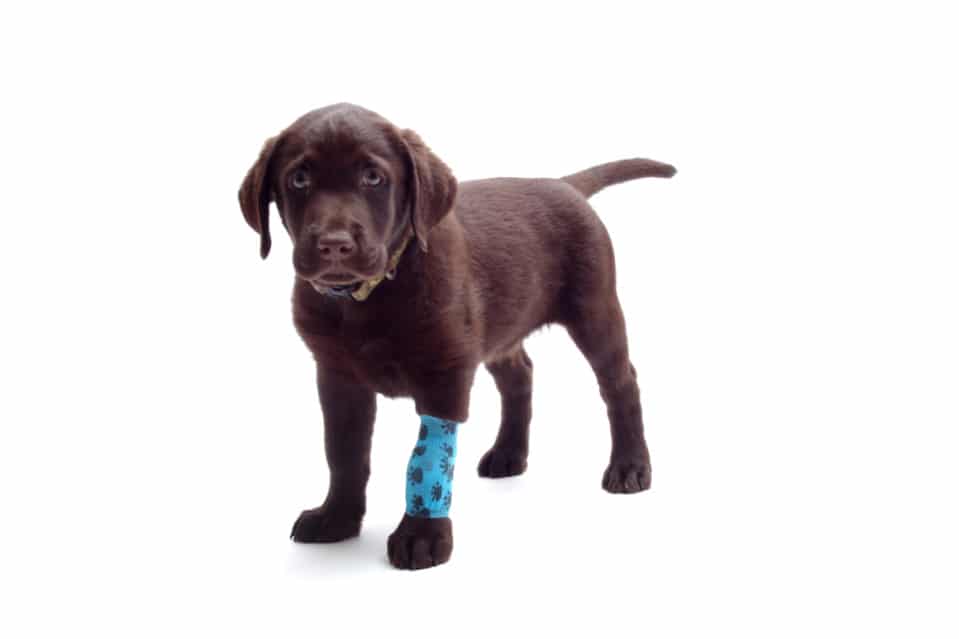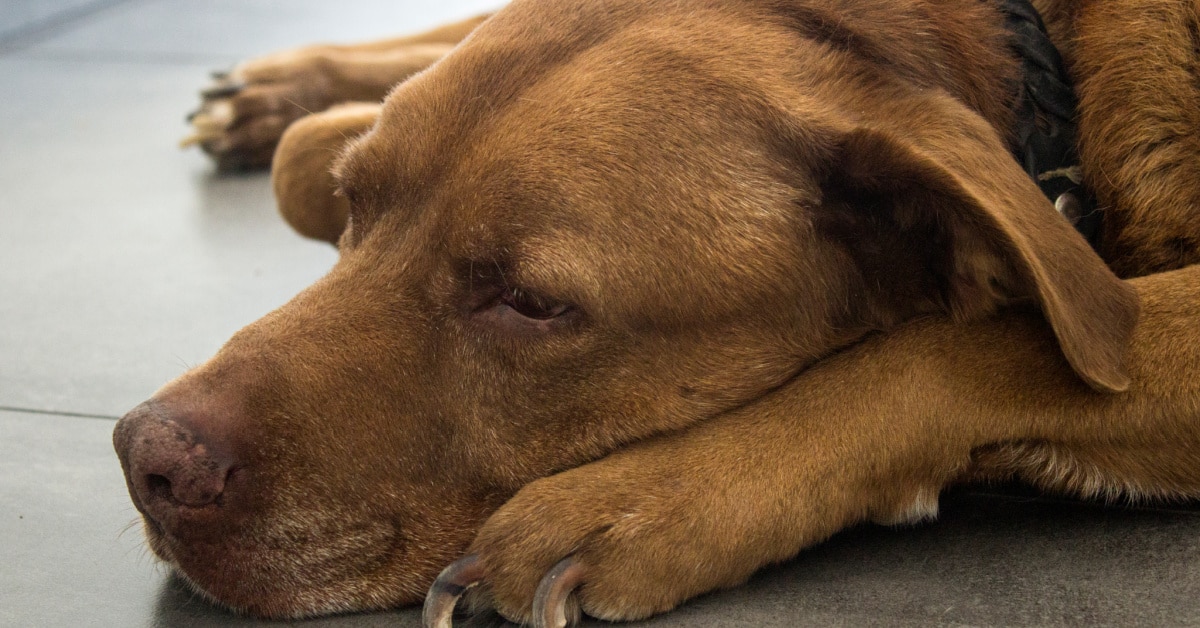Labrador Retrievers are generally healthy and energetic dogs that remain youthful for quite a long time. This is why it is alarming when you suddenly encounter Labrador back leg problems.
Mobility is very important for Labs, so Labrador rear leg problems can be a sign that things are going downhill.
There are a couple of various reasons behind your Labrador’s back leg problems.
In this article, we will go over those reasons for Labrador hind leg problems and see how best you can help your Lab.
Spotting these problems early on may be crucial in making sure that your dog can get treatment as soon as possible and that they won’t be in pain.
Each situation is different, though, so we will also try to take a look at how you can spot early signs of these issues.
What can cause hind leg problems in Labrador Retrievers?
1) Hip Dysplasia
Hip Dysplasia is a skeletal condition that many consider as a potential reason for Labrador Retriever hind leg problems.
It has various causes. So, if your dog has hip dysplasia, there are several possible reasons why.
First off, Canine Hip Dysplasia can be a genetic health issue. On top of that, it also disproportionately affects larger breeds, such as the Labs, much more than smaller breeds.
There are also other factors behind Labrador back leg problems like this, such as how much exercise a Labrador Retriever gets and other nutritional factors. We’ll go over some of them one by one in a bit.
To understand what hip dysplasia is and how it affects a Labrador, you have to know the mechanism of how the affected area works.
The hip joint is a ball-and-socket type of joint. In healthy dogs, this joint should move against each other smoothly without any issues at all.
However, dogs with Hip Dysplasia will have trouble with this, as the ball and socket grind up against each other instead of moving smoothly.
In short, there will be a lot of grinding, which then leads to losing mobility in that joint.
Eventually, if left untreated, this joint may lose function due to the abrasive nature of friction.
Hip Dysplasia will cause your Lab pain and discomfort, so it is incredibly crucial to spot it on time so that you can get your Lab the proper treatment, and they can move in relative comfort.
Now that you understand how Hip Dysplasia can affect your Labrador, let’s move on to the various causes of the disorder.
Causes of hip dysplasia
1) Genetics
Before anything else, genetics plays a major role in canine dysplasia.
Because of this, it is important to make sure that you buy from a reputable breeder that clears their puppies from this disorder.
If you are adopting, there’s no guarantee that your Labrador Retriever puppy will not have hip dysplasia since it will be impossible to tell immediately when they are still a few months old.
Most diagnoses of hip dysplasia occur at 6-18 months, although symptoms could also manifest a few years into your dog’s life.
Still, early diagnosis is important to make sure that you take the appropriate measures to alleviate any discomfort for your dog.
Take note that a lot of factors can contribute to hip dysplasia. So, while genetics can play a major role, the rest of the factors can exacerbate the dog’s condition and make their dysplasia more severe.
2) Exercise
How much or how little exercise your Lab gets, plays a role in hip dysplasia as well.
Labradors that don’t get enough exercise are likely to become larger. What’s even worse is that obesity can make canine dysplasia worse, or even cause it in some scenarios.
On the other hand, one thing you should also know is that if your Lab gets too much exercise (especially when they are still puppies), this might cause a lot of stress in their joints.
Ultimately, it can also cause dysplasia or make it worse.
3) Nutrition
Nutrition is another important factor that can result in hip dysplasia. One of the causes of hip dysplasia is excessive growth that the dog’s body can’t keep up with.
There are certain types of dog food that are specifically made to help puppies from large breeds appropriately manage their growth rates.
Hence, you can tell that proper health management is already a decent precaution for hip dysplasia.
You cannot prevent the skeletal disorder if it is genetic, but you can certainly make the proper preparations to not exacerbate the condition.
Symptoms of hip dysplasia
According to this study, symptoms of hip dysplasia greatly depend on the severity of the condition and on the disorder’s progression.
However, lameness in the back legs is one of the behaviors generally attributed to canine hip dysplasia.
Other symptoms include:
- Odd gait
- Difficulty with movement
- Limited mobility
- Grating in the joint when moving
- Stiffness in their movements
- Limping
If you notice that your Labrador Retriever has some of these symptoms, you should get them checked immediately.
Proper intervention methods for canine hip dysplasia
There are surgical and nonsurgical options for hip dysplasia treatments. Nonsurgical treatment options are best for mild cases.
This treatment can be anything from weight loss (if your Labrador is overweight) to taking anti-inflammatory and pain management medications.
In terms of surgical options, these are usually reserved for more severe cases and are not applicable to all Labs.
For instance, there are certain measures to determine if a Labrador Retriever is a good candidate for surgery or not.
If they are, then options like hip replacement, double or triple pelvic osteotomy, and femoral head ostectomy are available for them.
Managing your Labrador’s hip dysplasia will make a huge difference in them leading a comfortable life. You can start by avoiding stairs and jumping.
We also recommend consulting with your vet for exercise options that are safe for your Lab.
2) Injuries

Since Labradors are energetic dogs, there is also the possibility of injuries causing problems with their hind legs.
First, they could have strains or sprains from their daily activities. For these injuries, surgical intervention is usually not the first choice.
Just make sure to get your dog to the vet so that your vet will prescribe treatment methods that could involve medication for pain and swelling.
Anterior cruciate ligament (ACL) injuries are also relatively common in Labrador Retrievers. This could be a partial or complete tear in the knee ligament.
ACL injuries usually require surgical treatment to prevent the injury from progressing and help your Lab regain regular mobility.
Your Labrador could also suffer from broken bones (fractures). When this happens, make sure to get them medical attention and follow what your vet prescribes.
You should limit their movement for the next week or two depending on what your vet will advise. Every situation is different, so you have to follow your vet’s medical opinion.
Unfortunately, many injuries come unprecedented and are usually by accident. The best way to prevent injuries is to avoid putting your Labrador Retriever in precarious environments that could injure them.
Still, injuries can happen even at home, so there really is no guarantee.
3) Arthritis
Arthritis is also one of the most common Labrador back leg problems, especially as they get older. It is usually caused by many things, including trauma or degeneration of the joints over the years.
Arthritis is very common in the elbows and the hips, so it can affect your Lab’s back legs.
By the time your dog goes over the age of 8 or 9, they are at a higher risk of arthritis. This significantly impacts their mobility if not managed properly.
Arthritis can be managed with proper medication and care. Weight loss is also a good option if your dog is overweight since it can help ease some of the pressure from the joints.
In any case, it is important to consult with a vet for proper treatment options so that your Lab will not suffer any pain or discomfort.
Conclusion
There are a lot of factors that can lead to you having Labrador back leg problems, including hip dysplasia, injuries, and arthritis.
The most important thing you can do for your Labrador Retriever is to get an early diagnosis from your vet.
This way, you will be able to look for potential treatments early on.
In the meantime, it is also crucial that you do everything to give your Lab the support they need.
Padded beddings, for instance, can help support their joints when they sleep in their bed.







